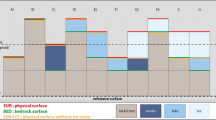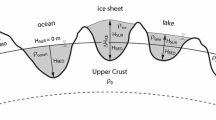Abstract
Topographic–isostatic masses represent an important source of gravity field information, especially in the high-frequency band, even if the detailed mass-density distribution inside the topographic masses is unknown. If this information is used within a remove-restore procedure, then the instability problems in downward continuation of gravity observations from aircraft or satellite altitudes can be reduced. In this article, integral formulae are derived for determination of gravitational effects of topographic–isostatic masses on the first- and second-order derivatives of the gravitational potential for three topographic–isostatic models. The application of these formulas is useful for airborne gravimetry/gradiometry and satellite gravity gradiometry. The formulas are presented in spherical approximation by separating the 3D integration in an analytical integration in the radial direction and 2D integration over the mean sphere. Therefore, spherical volume elements can be considered as being approximated by mass-lines located at the centre of the discretization compartments (the mass of the tesseroid is condensed mathematically along its vertical axis). The errors of this approximation are investigated for the second-order derivatives of the topographic–isostatic gravitational potential in the vicinity of the Earth’s surface. The formulas are then applied to various scenarios of airborne gravimetry/gradiometry and satellite gradiometry. The components of the gravitational vector at aircraft altitudes of 4 and 10 km have been determined, as well as the gravitational tensor components at a satellite altitude of 250 km envisaged for the forthcoming GOCE (gravity field and steady-state ocean-circulation explorer) mission. The numerical computations are based on digital elevation models with a 5-arc-minute resolution for satellite gravity gradiometry and 1-arc-minute resolution for airborne gravity/gradiometry.
Similar content being viewed by others
References
Abd-Elmotaal H (1995a) Theoretical background of the Vening Meinesz isostatic model. In: Sünkel H, Marson I (eds) Gravity and geoid. Springer, Heidelberg, pp 268–277
Abd-Elmotaal H (1995b) Attraction of the topographic masses. Bull Geod 69:304–307
Gradshteyn IS, Ryzhik IM (1980) Tables of integrals, series, and products. Academic, New York
Heck B (2003) On Helmert’s methods of condensation. J Geod 77(3–4):155–170. doi:10.1007/s00190-003-0318-5
Heck B, Wild F (2005) Topographic-isostatic reductions in satellite gravity gradiometry based on a generalized condensation model. In: Sansó F (ed) A window on the future of geodesy. Springer, Heidelberg, pp 294–299
Heck B, Seitz K (2007) A comparison of the tesseroid, prism and point-mass approaches for mass reductions in gravity field modelling. J Geod 81(2):121–136. doi:10.1007/s00190-006-0094-0
Heiskanen WA, Moritz H (1967) Physical geodesy. WH Freeman, San Francisco
Holmes SA, Featherstone WE (2002) A unified approach to the Clenshaw summation and the recursive computation of very high degree and order normalized associated Legendre functions. J Geod 76(5):279–299. doi: 10.1007/s00190-002-0216-2
Ilk KH (1993) Regularization for high resolution gravity field recovery by future satellite techniques. In: Anger G et al. (eds) Inv. probl. principles and applications in geophysics, technology and medicine, mathematical research, vol 74. Akademie Verlag GmbH, Berlin
Ilk KH (1998) A proposal for the determination of optimal regularization parameters in Tikhonov-type regularization methods. In: Proc. of the international seminar on model optimization in exploration geophysics, vol 2. Friedr. Vieweg und Söhne, Braunschweig-Wiesbaden
Ilk KH (2000) Envisaging a new area of gravity field research. In: Rummel R, Drewes H, Bosch W, Hornik H (eds) Towards an integrated global geodetic observing system (IGGOS). Springer, Heidelberg, pp 53–62
Kuhn M (2000) Geoidbestimmung unter Verwendung verschiedener Dichtehypothesen. Deutsche Geodätische Kommission, Rh. C, Heft Nr 250, Munich
Kuhn M (2003) Geoid determination with density hypotheses from isostatic models and geological information. J Geod 77(1–2):50–65. doi: 10.1007/s00190-002-0297-y
Kuhn M, Seitz K (2005) Comparison of Newton’s integral in the space and frequency domain. In: Sansó F (ed) A window on the future of geodesy. Springer, Heidelberg, pp 386–391
Makhloof AA (2007) The use of topographic-isostatic mass information in geodetic application, Disseratation D98, Institute of Geodesy and Geoinformation, Bonn
Martinec Z (1998) Boundary-value problems for gravimetric determination of a precise geoid. Lecture Notes in Earth Sciences, vol 73. Springer, Heidelberg
Nagy D (1966) The gravitational attraction of a right rectangular prism. Geophysics 31:362–371
NOAA (1988) Data Announcement 88-MGG-02. Digital relief of the surface of the Earth, National Geophysical Data Centre, Boulder
Novák P, Vaniček P, Martinec Z, Véronneau M (2001) Effect of the spherical terrain on gravity and the geoid. J Geod 75(9–10): 491–504. doi:10.1007/s001900100201
Novák P, Grafarend EW (2005) The ellipsoidal representation of the topographical potential and its vertical gradient. J Geod 78(11–12): 691–706. doi:10.1007/s00190-005-0435-4
Novák P, Grafarend EW (2005) The effect of topographic and atmospheric masses on spaceborne gravimetric and gradiometric data. Stud Geophys Geod 50:549–582
Rummel R, Rapp RH, Sünkel H, Tscherning CC (1988) Comparisons of global topographic–isostatic models to the Earth’s observed gravity field. Rep 388, Department of Geodetic Science and Surveying. The Ohio State University, Columbus
Schwarz KP, Sideris MG, Forsberg R (1990) The use of FFT techniques in physical geodesy. Geophys J Int 100:485–514
Smith DA, Robertson DS, Milbert DG (2001) Gravitational attraction of local crustal masses in spherical coordinates. J Geod 74(11–12): 783–795. doi:10.1007/s001900000142
Smith DA (2002) Computing components of the gravity field induced by distant topographic masses and condensed masses over the entire Earth using the 1-D FFT approach. J Geod 76(3):160–168. doi: 10.1007/s00190-001-0227-4
Sjöberg LE (1998) The exterior Airy/Heiskanen topographic–isostatic gravity potential, anomaly and the effect of analytical continuation in Stokes’ formula. J Geod 72(11):654–662. doi:10.1007/s001900050205
Sünkel H (1985) An isostatic Earth model. Report 367, Department of Geodetic Science and Surveying. The Ohio State University, Colubus
Tenzer T, Vaníček P, Novák P (2003) Far-zone contributions to topographical effects in the Stokes–Helmert method of the geoid determination. Stud Geophys Geod 47:467–480
Tscherning CC (1976) Computation of the second-order derivatives of the normal potential based on the representation by a Legendre series. Manuscr Geod 1:71–92
Tsoulis D (1999) Spherical harmonic computations with topographic/isostatic coefficients. Reports in the series IAPG / FESG (ISSN 1437-8280), Rep. No. 3 (ISBN 3-934205-02-X), Institute of Astronomical and Physical Geodesy, Technical University of Munich
Tsoulis D (2001) A Comparison between the Airy–Heiskanen and the Pratt–Hayford isostatic models for the computation of potential harmonic coefficients. J Geod 74(9):637–643. doi:10.1007/s001900000124
Vening-Meinesz FA (1940) Fundamental tables for regional isostatic reduction of gravity values. Publ. Netherlands Acad. Sci.
Vening-Meinesz FA (1941) Tables for regional and local isostatic reduction (Airy System) for gravity values. Publication of the Netherlands Geodetic Commission, Delft
Wild F, Heck B (2004a) A comparison of different isostatic models applied to satellite gravity gradiometry. In: Jekeli C, Bastos L, Fernandes J (eds) Gravity, geoid and space missions, GGSM 2004. Springer, Heidelberg, pp 230–235
Wild F, Heck B (2004b) Effects of topographic and isostatic masses in satellite gravity gradiometry. In: Proceedings of 2nd International GOCE user workshop, Frascati, March
Author information
Authors and Affiliations
Corresponding author
Rights and permissions
About this article
Cite this article
Makhloof, A.A., Ilk, KH. Effects of topographic–isostatic masses on gravitational functionals at the Earth’s surface and at airborne and satellite altitudes. J Geod 82, 93–111 (2008). https://doi.org/10.1007/s00190-007-0159-8
Received:
Accepted:
Published:
Issue Date:
DOI: https://doi.org/10.1007/s00190-007-0159-8




